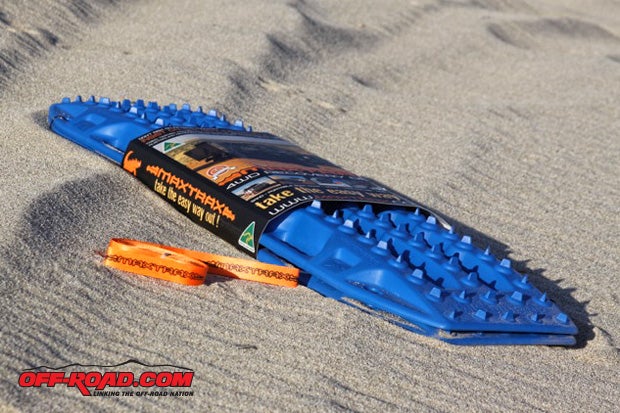
Being prepared can make the difference between having a little hiccup or a complete train wreck on the trail. Having the right equipment for the job can also make these unexpected hurdles less daunting. For this reason, we’re always on the lookout for tools that will help make off-road adventures go smoothly. MAXTRAX is one of those tools. What piqued our interest was how easy and effective this tool is at extracting and recovering a stuck vehicle using its own wheel power.
Get the Flash Player to see this player. |
The MAXTRAX was developed by Brad McCarthy, author of Dirty Weekends “The Essential 4WD Guides” (http://www.dirtyweekends.com.au/), after getting bogged down at the beach and almost losing his 4x4 to the incoming tide. This was in spite of having traditional recovery gear. The stressful incident sparked an idea to develop a system that would make recovery and extraction easy and safe for a single person—with no need for towing, snatching or winching. Four years later, the MAXTRAX was introduced in Australia, followed with an introduction at SEMA in 2010. Since its inception, the MAXTRAX has been finding its way into off-road vehicles around the world.

The manufacturer describes the MAXTRAX as an “innovative, lightweight vehicle recovery device that's Australian designed & engineered, and rigorously tested and proven in the world's toughest offroad events and expeditions as the safe, simple, quick and easy method of 4WD vehicle recovery.” We had the opportunity to meet KC Steiner from MAXTRAX America and get our hands on a set to test. After using the MAXTRAX ourselves, we agree that they work well and are very easy to use, as they much faster than winching and on par with strapping.

In 2012 the MAXTRAX was redesigned with some improvements to make recovery effectiveness even better. The new MKII MAXTRAX has more teeth (88 in total) for even better grip, and three longitudinal beams instead of two for added strength. They also changed the circular holes in the corners into keyholes to fit the new mounting pins and linking straps. MAXTRAX also added more color options to supplement the original safety orange model.
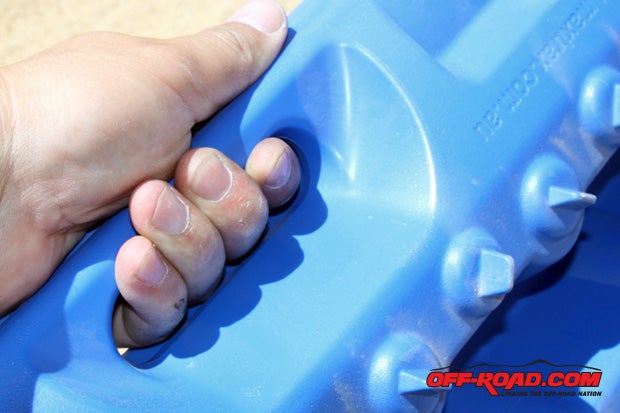
MAXTRAX are made from a durable, UV-resistant nylon blend, similar to that used in modern tactical weapons. It features six handles (three on each side) that make maneuvering and handling them feel natural. During our testing, we learned that MAXTRAX are flexible and have great memory. We put our 6,000-pound truck on top of a single set of ramps in a ditch until they wrapped around the tire. When we drove off them, they sprung right back up to their original state. They didn’t break or show any stretch marks. Try that with a knock-off brand.
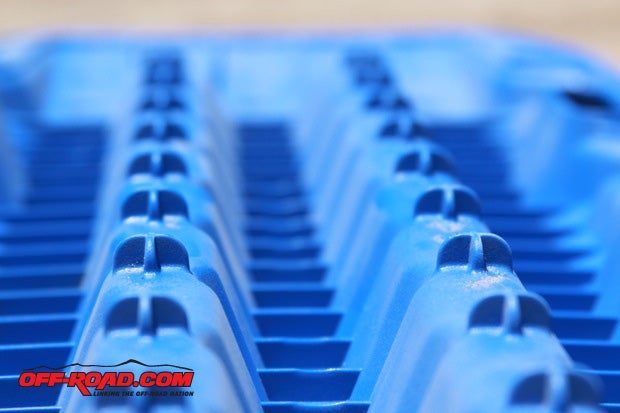
To stay planted, the MAXTRAX has a number of engineered features built into the belly. A series of 20 raised crosses, 60 horizontal walls and three vertical valleys help give the MAXTRAX grip when packed against the ground. Dirt, sand, mud and snow can easily pack into these voids, giving the MAXTRAX added stability when in use.

MAXTRAX are really easy to use. You simply clear debris and obstructions from around tires and axles (dirt, sand, mud, snow). It's important that the wheels are bearing the weight of the vehicle and not spinning freely in mid-air. The MAXTRAX can be inverted and used as a shovel, but a long-handle shovel may be needed for deeper bogs or to get further underneath the truck.

Next is wedging the MAXTRAX firmly against the tire tread. Either side will do, as these ramps are bi-directional. You can drive forward or backwards, placing MAXTRAX in front of both front tires if driving forward, or behind both rear tires if going in reverse. The MAXTRAX should be placed at a slight angle, rather than laying flat, to ensure a good bite. Airing down tires may also help during extraction if it hasn’t been done already. Less air equals more traction.
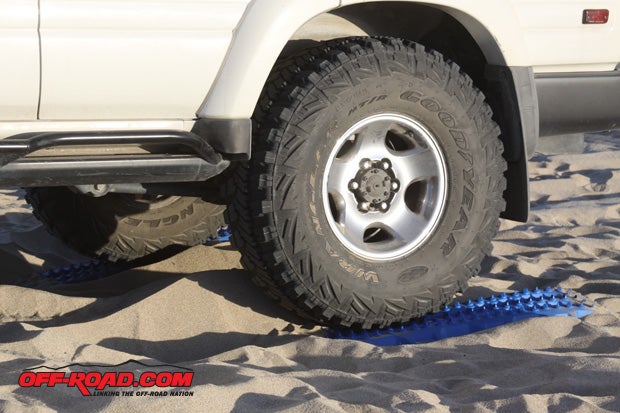
Back inside the cab, MAXTRAX recommends that low range be engaged and that the driver gently accelerate. The slow rotation allows the tires to grip the lugs on the top of the MAXTRAX and draw them under. If tires don't immediately grip the MAXTRAX, stop, and reposition them firmly against the tire threads. Once the tire gains traction, maintain the momentum until the vehicle reaches firm ground.

CAUTION: Wheel spin can damage the MAXTRAX by creating heat and melting the material away. While testing the MAXTRAX using a diesel Cummins truck, the torque monster spun out the wheels—partially flattening down the first few rows of teeth. We were sad to see the damage at first, but happy after we repositioned the MAXTRAX and were able to drive out of the sand with no problems. This type of damage is not covered by warranty and the manufacturer does clearly state DO NOT SPIN WHEELS. We’ll try to easy up on the skinny pedal next time. Sorry KC.

In addition to being a recovery and extraction device, the MAXTRAX can also be used as a bridge to get your vehicle across deep sand, snow or mud. This requires at least four MAXTRAX and linking straps to keep them together. The MAXTRAX can also be used as a bridge when voids are a problem (e.g.: trail washout). For the best results, multiple MAXTRAX stacked together will provide a more stable surface with minimal deflection. Stacking a few rocks underneath should also help stabilize the surface.
MAXTRAX ACCESSORIES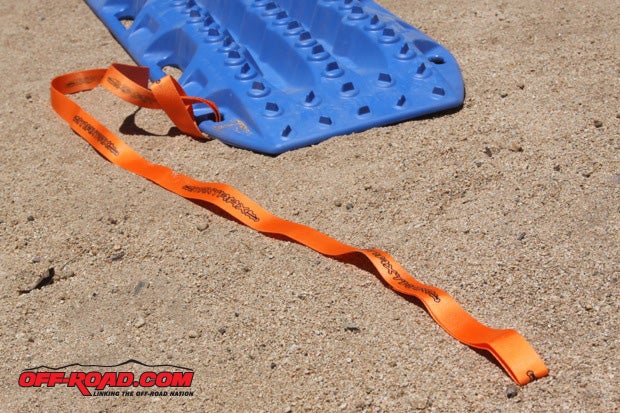
MAXTRAX offers a number of accessories that work in tandem with their product. Recovery straps can make finding the MAXTRAX easier when they become buried in sand or mud following a recovery. Linking straps and spikes help keep them fixed and together when traveling over multiple MAXTRAX. They also offer various vehicle mounting options, such as mounting pins that can be added to a factory roof rack, or a tire rack that attaches to the rear tire carrier.
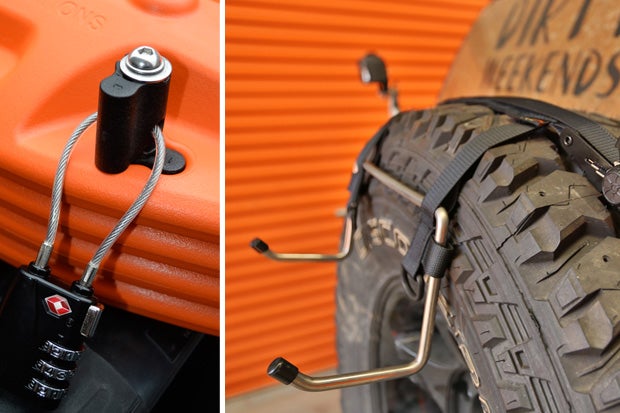
Since we already had a Baja Rack system mounted on our vehicle, we chose to use their MAXTRAX mount. The Baja Rack bracket system uses all four corner keyholes to fasten and secure the MAXTRAX using stainless hardware. Since MAXTRAX fit snugly together, they don’t take up a lot of room. Two are just 3.3" thick and four are only 4.6" thick. You can fit up to 4 MAXTRAX per bracket set. The vertical orientation of the Baja Rack bracket also maximizes cargo space and displays the MAXTRAX nicely.
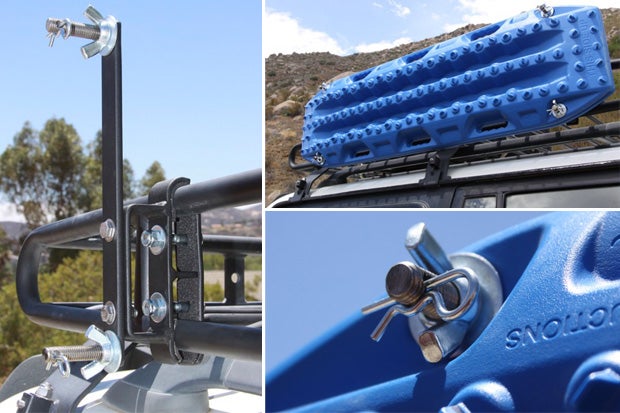
We’re happy to report that the fin-like Baja Rack mount design doesn’t create any wind noise while traveling at highway speed with MAXTRAX attached. They’re also very sturdy, as the bracket is formed using steel. If you’re not familiar with the brand, Baja Rack makes nice off-road adventure racks for popular 4x4 Truck and SUV models. We’ve had our rack in service since 2011 with no issues, and we have friends who’ve been running them much longer (See related Baja Rack Story).
FINAL THOUGHTS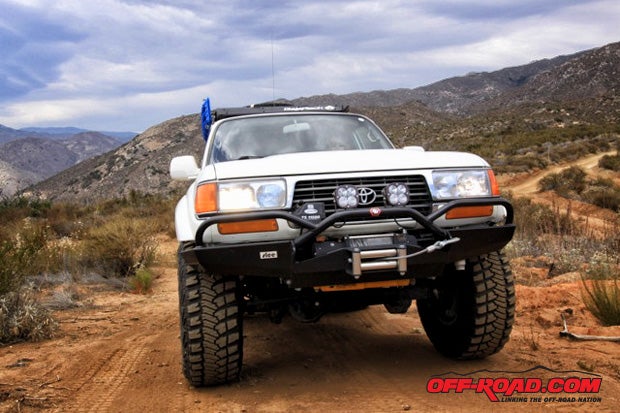
Overall, we think the MAXTRAX is a great recovery tool that can be added to any off-roader’s trail tools arsenal. They’re well engineered and built for the job. No matter if it’s sand, silt, high alpine snow or nasty chunky mud—these things can save your butt and get you moving forward faster. They can also complement traditional recovery techniques so loads and stress are less on equipment (e.g.: using MAXTRAX and a winch together). In some cases, MAXTRAX may be your only option.
If you find yourself venturing off to areas where the stakes are high and the terrain is loose, we highly recommend getting a set of MAXTRAX. You’ll spend more time driving behind the wheel or relaxing next to a campfire rather than spending hours digging yourself out.
SOURCE
MAXTRAX America
http://www.maxtraxamerica.com/
(316) 213-2482
Baja Rack
http://www.bajarack.com/
(888) 538-0588


 Your Privacy Choices
Your Privacy Choices